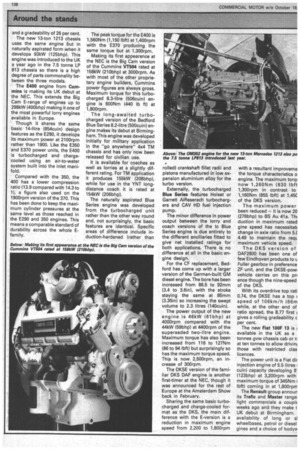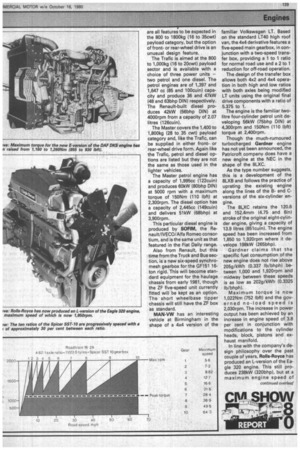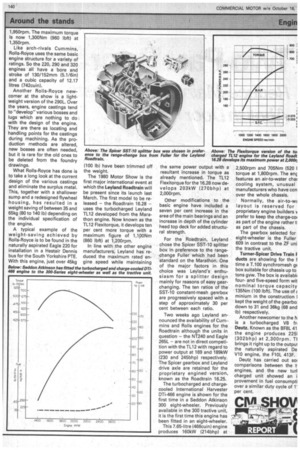You name it, they've got it!
Page 139

Page 140

Page 141

Page 142

If you've noticed an error in this article please click here to report it so we can fix it.
Turbocharged or naturally aspirated, synchro or constant mesh, single or double reduction —all the possible variations in drivelines are here, writes Graham Montgomerie
DRIVELINE features Ind among the Mercedes! exhibits including a mod
version of the 0M402 V8 ne. This basic engine has ered the 1626S since its ■ duction to the UK market in I. Now the vehicle has been ited as Mercedes felt that 190kW (256bhp) in its inal form, it was overspecifor the lightweight 32-ton ket and underpowered for ,e interested in the higher 'er 40-tonne machines.
ie 0M422 is derived from 0M402 and stays naturally rated, but the bore has been aased from 125 to 128mm
2 to 5.03in) and the stroke -1 130 to 142mm (5.12 to in). This has resulted in a
per cent increase in engine iacity with the 0M422 lining 14.26 litres (870cuin). long with almost the entire me-building industry, Mer s-Benz has reduced the erned speed from 2500 to Jrpm. This has improved the we characteristics and will help engine wear over the ice's life, both features other nufacturers have emsisecl.
Mercedes' case, however, substantial increase (nearly per cent) in the stroke will e stepped up the piston ed so a decrease in engine
3 is of benefit on a number of nts.
/ith the 422, the maximum we of 1040Nm (767 Ibft) is
developed at 1200rpm instead of the 1600rpm of the earlier design. According to Mercedes the profile of the torque curve gives a useable spread of 65 per cent of the total engine speed range.
For the lighter end of the market Mercedes-Benz has developed a de-rated version of the same engine. Known as the 0M422 III (The higher-powered version is the OM 422 l), it develops 184kW (247bhp) at 2300rpm with a maximum tor que of 930Nm (687 lbft) at 120Orpm.
Mercedes claim that the 1628S has achieved a ten per cent improvement in fuel consumption over the smaller engined 1626S.
Other engine modifications to the V8 include revised fuel-injection characteristics, oil jet piston cooling, a new liner seal and a move from four to six head bolts. These bolts are also pretensioned to obviate the need• for subsequent tightening in ser To match the torque characteristics of the new engine(s), an eight-speed ZF gearbox has been chosen. In contrast to the 1626 gearbox, the latest boxes are of the range-change type. A double-H shift pattern is used in contrast to the more usual superimposed H with a range switch.
Though an eight-speed unit is fitted to both the 1625 and 1628 chassis, there are detail differences.
The 1625 uses the 5S-92GP gearbox which has a lower torque capacity and a correspondingly lighter weight than the 5S-111GP box used in the more powerful model. This latter gearbox also incorporates a splitter section giving a total of 18 forward speeds including the two crawler ratios.
An interesting departure from previous Mercedes-Benz practice is the option of a 13speed constant-mesh Fuller gearbox for the 1628S with the possibility of it appearing in the lower-powered version at a later date.
Still with Mercedes, the company has brought out a tractiveunit version of the 1617 16-ton rigid designated the 1617S, in line with customary M-B practice. The engine is retained from the rigid and is one of the few Mercedes engines to be turbocharged.
This is the 125kW (168bhp) 0M353A and it drives through a 330mm (13in) diameter clutch to a range-change synchromesh gearbox. This differs from the rigid version in that it has an additional 13.36 to 1 crawler ratio giving nine speeds in all.
At 24 tons gcw, this crawler gear, in conjunction with the 5.86 to 1 rear axle ratio, permits a road speed of 92 km/h (57mph) and a gradeability of 26 per cent.
The new 13-ton 1213 chassis uses the same engine but in naturally aspirated form when it develops 93kW (125bhp). This engine was introduced to the UK a year ago in the 7.5 tonne LP 813 chassis so there is a high degree of parts commonality between the three models.
The E400 engine from Cummins is making its UK debut at the NEC. This extends the Big Cam E-range of engines up to 298kW (400bhp) making it one of the most powerful lorry engines available in Europe.
Though it shares the same basic 14-litre (854cuin) design features as the E290, it develops its maximum power at 2100rpm rather than 1900. Like the E350 and E370 power units, the E400 is turbocharged and chargecooled using an air-to-water system built into the inlet manifold.
Compared with the 350, the 400 has a lower compression ratio (13.9 compared with 14.3 to 1), a figure also used on the 1900rpm version of the 370. This has been done to keep the maximum cylinder pressures at the same level as those reached in the E290 and 350 engines. This means a comparable standard of durability across the whole Efamily. The peak torque for the E400 is 1,560N m (1,150 lbft) at 1,400rpm with the E370 producing the same torque but at 1,300rpm.
Making its first appearance at the NEC is the Big Cam version of the Cummins VT504 rated at 158kW (210bhp) at 3000rpm. As with most of the other proprietary engine builders, Cummins power figures are always gross. Maximum torque for this turbocharged 8.3-litre (506cuin) engine is 600Nm (440 lb ft) at 1,80Orpm.
The long-awaited turbocharged version of the Bedford Blue Series 8.2-litre (500cuin) engine makes its debut at Birmingham. This engine was developed initially for military application in the "go anywhere" 4x4 TM chassis and has only now been released for civilian use.
lt is available for coaches as well as lorries at a slightly different rating. For TM application it produces 155kW (208bhp), while for use in the YNT longdistance coach it is rated at 154kW (206bhp).
The naturally aspirated Blue Series engine was developed from the turbocharged unit rather than the other way round and, not surprisingly, the basic features are identical. Specific areas of difference include induction-hardened (rather than rolled) crankshaft fillet radii and pistons manufactured in low expansion aluminium alloy for the turbo version.
Externally, the turbocharged Blue Series features Holset or Garrett AiReserach turbochargers and CAV HD fuel injection pump.
The minor difference in power output between the lorry and coach versions of the tc Blue Series engine is due entirely to the different ancillaries fitted to give net installed ratings for both applications. There is no _difference at all in the basic engine design.
For the CF replacement, Bedford has come up with a larger version of the German-built GM diesel engine. The bore has been increased from 86.5 to 92mm (3.4 to 3.6in), with the stroke staying the same at 85mm (3.35in) so increasing the swept volume to 2.3 litres (140cuin).
The power output of the new engine is 46kW (61bhp) at 4000rpm compared with the 44kW (59bhp) at 4400rpm of the superseded two-litre engine. Maximum torque has also been increased from 116 to 127Nm (86 to 94 lbft) but surprisingly so has the maximum torque speed. This is now 2,500rpm, an increase of 300rpm.
The DKSE version of the familiar DKS DAF engine is another first-timer at the NEC, though it was announced for the rest of Europe at the Amsterdam Show back in February.
Sharing the same basic turbocharged and charge-cooled format as the DKS, the main difference with the E-version is a reduction in maximum engine speed from 2,200 to 1,800rpm with a resultant improveme the torque characteristics o engine. The maximum torqi now 1,260Nm (930 lbft 1,300rpm in contrast to 1,160Nm (855 lbft) at 1,45C of the DKS version.
The maximum power been reduced — it is now 20 (276bhp) to BS Au 41a. Tho duction in maximum rated gine speed has necessitat( change in axle ratio from 5.( 4.49 to maintain the reqL maximum vehicle speed.
The DKS version of DAF2800 has been one of few Eindhoven products to u Fuller gearbox in preference ZF unit, and the DKSE-pow, vehicle carries on this pn ence though the nine-speed of the DKS.
With its overdrive top rati 0.74, the DKSE has a top speed of 106km/h (66m while, at the other end of ratio spread, the 8.77 first 1 gives a rolling gradeability c per cent.
The new Fiat 100F 13 is I available in the UK as a tonnes gvw chassis cab or n at ten tonnes to allow driviril those with restricted clas licences.
The power unit is a Fiat dir injection engine of 5.5 litres cuin) capacity developing 9' (123bhp) at 3,200rpm with maximum torque of 345N m I lbft) coming in at 1,800rpm The Renault group armours its Trafic and Master range: light commercials a couplE weeks ago and they make t UK debut at Birmingham. availability of long or sl wheelbases, petrol or diesel gines and a choice of bodyvs are all features to be expected in the 800 to 1800kg (16 to 35cwt) payload category, but the option of frontor rear-wheel drive is an unusual design feature.
The Trafic is aimed at the 800 to 1,000kg (16 to 20cwt) payload sector and is available with a choice of three power units — two petrol and one diesel. The petrol engines are of 1,397 and 1,647 cc (85 and 100cuin) capacity and produce 36 and 47kW (48 and 63bhp DIN) respectively. The Renault-built diesel produces 42kW (56bhp DIN) at 4000 rpm from a capacity of 2.07 litres (126cuin).
The Master covers the 1,400 to 1,800kg (28 to 35 cwt) payload category and, like the Trafic, can be supplied in either frontor rear-wheel drive form. Again like the Trafic, petrol and diesel options are listed but they are not the same as those used in the lighter vehicles.
The Master petrol engine has a capacity of 1,995cc (122cuin) and produces 60kW (80bhp DIN) at 5000 rpm with a maximum torque of 150Nm (110 lbft) at 2,300rpm. The diesel option has a capacity of 2,445cc (149cuin) and delivers 51kW (68bhp) at 3,90Orpm.
This particular diesel engine is produced by SOFIM, the Renault/IVECO/Alfa Romeo consortium, and is the same unit as that featured in the Fiat Daily range.
Also from Renault, but this time from the Truck and Bus section, is a new six-speed synchromesh gearbox for the GF151 16ton rigid. This will become standard equipment for the haulage chassis from early 1981, though the ZF five-speed unit currently fitted will be kept as an option. The short wheelbase tipper chassis will still have the ZF box as standard.
MAN-VW has an interesting vehicle at Birmingham in the shape of a 4x4 version of the familiar Volkswagen LT. Based on the standard LT40 high roof van, the 4x4 derivative features a five-speed main gearbox, in conjunction with a two-speed transfer box, providing a 1 to 1 ratio for normal road use and a 2 to 1
reduction for off-road operation. The design of the transfer box allows both 4x2 and 4x4 opera
tion in both high and low ratios with both axles being modified LT units using the original final drive components with a ratio of 5.375 to 1.
The engine is the familiar twolitre four-cylinder petrol unit developing 56kW (75bhp DIN) at 4,300rpm and 150Nm (110 1b11) torque at 2,400rpm.
Though the much-rumoured turbocharged Gardner engine has not yet been announced, the Patricroft company does have a new engine at the NEC in the shape of the 8LXC.
As the type number suggests, this is a development of the 8LXB and follows the practice of uprating the existing engine along the lines of the Band Cversions of the six-cylinder engine.
The 8LXC retains the 120.6 and 152.4mm (4.75 and 6in) stroke of the original eight-cylin der engine, giving a capacity of 13.9 litres (851cuin). The engine speed has been increased from 1,850 to 1,920rpm where it develops 198kW (265bhp).
Gardner claims that the specific fuel consumption of the new engine does not rise above 205g/kWh (0.337 lb/bhph) between 1,000 and 1,920rpm and midway between these speeds is as low as 202g/kWh (0.3325 lb/bhph).
Maximum torque is now 1,022Nm (752 lbft) and the gov erned no-load speed is 2,030rpm. The increase in power output has been achieved by an increase in engine speed of 3.8 per cent in conjunction with modifications to the cylinder heads, block, pistons and exhaust manifold.
In line with the company's design philosophy over the past couple of years, Rolls-Royce has produced an L-version of the Eagle 320 engine. This still pro duces 238kW (320bhp), but at a maximum engine speed of 1,950rpm. The maximum torque is now 1,300Nm (960 lbft) at 1,35Orpm.
Like arch-rivals Cummins, Rolls-Royce uses the same basic engine structure for a variety of ratings. So the 220, 290 and 320 engines all have a bore and stroke of 130/152mm (5.1/6in) and a cubic capacity of 12.17 litres (742cuin).
Another Rolls-Royce newcomer at the show is a lightweight version of the 290L. Over the years, engine castings tend to "develop" various bosses and lugs which are nothing to do with the design of the engine. They are there as locating and handling points for the castings during machining. As the production methods are altered, new bosses are often needed, but it is rare for the old ones to be deleted from the foundry drawings.
What Rolls-Royce has done is to take a long look at the current design of the various castings and eliminate the surplus metal. This, together with a shallower sump and a redesigned flywheel housing, has resulted in a weight saving of between 35 and 65kg (80 to 140 lb) depending on the individual specification of the engine.
A typical example of the weight-saving achieved by Rolls-Royce is to be found in the naturally aspirated Eagle 220 for installation in a Hestair Dennis bus for the South Yorkshire PTE. With this engine, just over 45kg (100 lb) have been trimmed off the weight.
The 1980 Motor Show is the first major international event at which the Leyland Roadtrain will be present since its launch last March. The first model to be released — the Roadtrain 16.28 — uses the turbocharged Leyland TL12 developed from the Marathon engine. Now known as the TL12 Flexitorque, it develops ten per cent more torque with a maximum figure of 1,1p0Nm (860 lbft) at 1,200rpm.
In line with the other engine manufacturers, Leyland has reduced the maximum rated engine speed while maintaining the same power output with a resultant increase in torque as already mentioned. The TL12 Flexitorque for the 16.28 now develops 203kW (270bhp) at 2,00Orpm.
Other modifications to the basic engine have included a seven per cent increase in the area of the main bearings and an increase in depth of the cylinder head top deck for added structural strength.
For the Roadtrain, Leyland chose the Spicer SST-10 splitter box in preference to the rangechange Fuller which had been standard on the Marathon. One of the major factors in this choice was Leyland's enthusiasm for a splitter design mainly for reasons of easy gearchanging. The ten ratios of the SST-10 constant-mesh gearbox are progressively spaced with a step of approximately 30 per cent between each ratio.
Two weeks ago Leyland announced the availability of Cummins and Rolls engines for the Roadtrain although the units in question — the NT240 and Eagle 265L — are not in direct competition with the TL12 with regard to power output at 169 and 189kW (230 and 245bhp) respectively. The Spicer gearbox and Leyland drive axle are retained for the proprietary engined version, known as the Roadtrain 16.25.
The turbocharged and chargecooled International Harvester DTi-466 engine is shown for the first time in a Seddon Atkinson 300 eight-wheeler. Previously available in the 300 tractive unit, it is the first time this engine has been fitted in an eight-wheeler.
This 7.65-litre (466cuin) engine produces 160kW (214bhp) at 2,500rpm and 705Nm (520 I torque at 1,800rpm. The enc features an air-to-water char cooling system, unusual manufacturers who have con over the whole chassis.
Normally, the air-to-wi layout is reserved for proprietary engine builders sd prefer to keep the charge-col as part of the engine rather tl as part of the chassis.
The gearbox selected for eight-wheeler is the Fuller 609 in contrast to the ZF uni the tractive unit.
Turner-Spicer Drive Train F ducts are showing for the f time a T.100 synchromesh g( box suitable for chassis up to tons gvw. The box is availabli fourand five-speed form wit nominal torque capacity 135Nm (100 lbft). The use of minium in the construction I kept the weight of the gearbo: down to 31 and 36kg (68 and lb) respectively.
Another newcomer to the N is a turbocharged V8 fri Deutz. Known as the BF8L 41 the engine produces 2251 (302 bhp) at 2,300rpm. TI brings it right up to the outpul the naturally aspirated De V10 engine, the F1OL 413F.
Deutz has carried out soi comparisons between the t: engines, and the new turl charged unit showed an i provement in fuel consumpti over a similar duty cycle of 1' per cent.




























































































































































































































































































